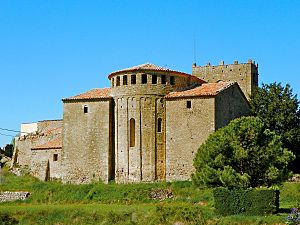Santa Maria, Serrateix facts for kids
Quick facts for kids Santa Maria de Serrateix |
|
|---|---|
| Native name Catalan: Monestir de Santa Maria |
|

Santa Maria de Serrateix
|
|
| Location | Viver i Serrateix, Catalonia, Spain |
| Architectural style(s) | Neoclassical |
| Official name: Monasterio de Santa María | |
| Type | Non-movable |
| Criteria | Monument |
| Designated | June 1, 1999 |
| Reference no. | RI-51-0010218 |
| Lua error in Module:Location_map at line 420: attempt to index field 'wikibase' (a nil value). | |
Santa Maria de Serrateix is a beautiful old church in Serrateix, Catalonia, Spain. It used to be part of a Benedictine monastery, which is a place where monks lived and prayed. The church itself is built in a style called Romanesque, which means it has thick walls and round arches. It is located in the Berguedà area of Catalonia.
Contents
History of Santa Maria de Serrateix
Early Beginnings of the Monastery
The story of this monastery began around the year 940. At that time, a group of monks decided to settle in this peaceful area. They wanted to create a place for prayer and quiet living.
Later, in 977, the monastery received special protection. Powerful leaders called the Counts of Cerdanya and Besalú became its protectors. During this time, a monk named Froila became the abbot, or leader, of the monastery. He was in charge from 977 to 993.
The monastery grew and became more important. It was home to 13 monks. It also received gifts and support from important people. One of these people was Oliba Cabreta, whose special stone coffin, called a sarcophagus, can still be found here. His brother Miró also helped the monastery.
Building and Changes Over Time
A new church was built at the monastery in 1077. It was officially opened and blessed in 1126. This shows how important the church was becoming.
In the 1300s, the monastery faced some challenges. Only six monks were living there at one point. The bell tower, which is a tall part of the church where bells hang, was destroyed. However, it was rebuilt in 1373 by a new abbot named Berenguer de Lluçà. After this, the monastery came under the authority of the Bishop of Urgell. This meant the Bishop had power over the monastery.
Modern Rebuilding and Protection
The church you see today was rebuilt between 1798 and 1827. It was changed to the Neoclassical style. This style uses ideas from ancient Greek and Roman buildings. The rest of the monastery buildings were also updated in the Neoclassical style. This work was finished in 1793 by an architect named Josep Torrevedella.
Sadly, the buildings were badly damaged during the Spanish Civil War. Many parts of the monastery where the monks lived and worked were destroyed.
Today, Santa Maria de Serrateix is a protected site. In 1982, the tomb of an old abbot, Berenguer de Torigues, was declared a special monument. It is now kept safe in the Museu Diocesà i Comarcal de Solsona. On June 1, 1999, Santa Maria de Serrateix itself was recognized as a "Bien de Interés Cultural." This means it is a very important cultural site in Spain.
See also
 In Spanish: Monasterio de Santa María de Serrateix para niños
In Spanish: Monasterio de Santa María de Serrateix para niños

